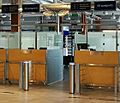Schengen facts for kids
The word Schengen is important for understanding travel in Europe. It refers to a special area where many European countries have agreed to let people travel freely between them without showing their passports at every border. This idea started with an agreement signed in a small village called Schengen.
Contents
What is the Schengen Area?
The Schengen Area is like a big zone made up of 29 European countries. In this zone, most border checks between these countries have been removed. This means you can travel from one Schengen country to another without stopping at a border checkpoint. It's almost like traveling between different states in one country!
Why was the Schengen Area created?
Before the Schengen Area, if you traveled across Europe, you would have to stop at each country's border to show your passport. This could take a lot of time and make travel difficult. The idea behind Schengen was to make travel easier and faster for people, goods, and services within Europe. It helps people move freely for work, holidays, or visiting family.
Which countries are in the Schengen Area?
The Schengen Area includes most countries in the European Union (EU), plus a few non-EU countries like Iceland, Liechtenstein, Norway, and Switzerland. Not all EU countries are part of it, and some non-EU countries are. For example, Ireland is in the EU but not in Schengen. Bulgaria and Romania joined the Schengen Area for air and sea borders in March 2024.
How do borders work in the Schengen Area?
Inside the Schengen Area, you usually won't see border guards or passport checks when you cross from one country to another. Instead, the focus is on controlling the external borders of the entire Schengen Area. This means that when you enter or leave the Schengen Area from a country outside it, you will go through passport control.
The Schengen Agreement
The idea for the Schengen Area started with a special document called the Schengen Agreement. This agreement was signed on June 14, 1985.
Where was the agreement signed?
The agreement was signed near a small village called Schengen in Luxembourg. This village is located where the borders of Luxembourg, France, and Germany meet. It was a symbolic place to sign an agreement about removing borders!
What did the agreement do?
The Schengen Agreement was the first step towards creating the free-travel zone. It set out the rules for how countries could remove their internal border controls. It also included rules for how to strengthen security at the external borders of the area. This helps keep the area safe while allowing people to move freely inside it.
Benefits of the Schengen Area
The Schengen Area has many benefits for people and businesses.
- Easier Travel: Tourists and travelers can explore many countries without constant border checks. This makes holidays and business trips much simpler.
- Economic Growth: Businesses can move goods and services more easily across borders, which helps the economy grow.
- Cultural Exchange: It encourages people from different countries to visit each other, learn about new cultures, and build stronger connections.
Images for kids
-
At the border crossing point in Brod na Kupi on the Croatia–Slovenia border, the Croatian border checkpoint is not staffed. Instead, Croatian border guards carry out border checks together with their Slovenian counterparts at the Slovenian border checkpoint in Petrina on the other side of the Kupa river.
-
A typical Schengen internal border crossing has no border control post and only a common EU-state sign displaying the name of the country being entered, as here between Germany and Austria. The larger blue sign announces entry to the Federal Republic of Germany in German, the smaller white sign announces entry into the German state of Bavaria.
-
EasyPASS self-service gates which eligible travelers can use to clear border control at Munich Airport, Germany.
-
Exit stamp for air travel issued at Prague airport.
-
Exit stamp for sea travel, issued at Helsinki port.
See also
 In Spanish: Espacio Schengen para niños
In Spanish: Espacio Schengen para niños




















